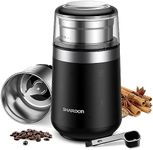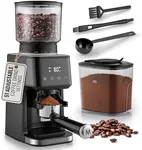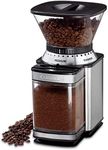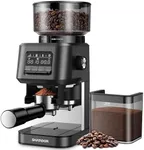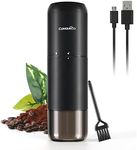Buying Guide for the Best Coffe Grinders
Choosing the right coffee grinder is essential for any coffee enthusiast who wants to enjoy the best possible flavor from their coffee beans. The right grinder can make a significant difference in the taste and aroma of your coffee. When selecting a coffee grinder, it's important to consider several key specifications to ensure you get the best fit for your needs. Here are the main factors to consider and how to navigate them.Grind Size SettingsGrind size settings refer to the different levels of coarseness or fineness that a grinder can produce. This is important because different brewing methods require different grind sizes. For example, espresso requires a very fine grind, while French press needs a coarse grind. Grinders with multiple settings offer more versatility. If you enjoy experimenting with different brewing methods, look for a grinder with a wide range of settings. If you stick to one method, a grinder with fewer settings may suffice.
Grind ConsistencyGrind consistency refers to how uniform the coffee particles are after grinding. Consistency is crucial for even extraction and balanced flavor. Burr grinders generally provide more consistent grinds compared to blade grinders. If you are serious about your coffee and want the best flavor, opt for a burr grinder. Blade grinders can be less expensive but may produce uneven grinds, which can affect the taste of your coffee.
Grinder TypeThere are two main types of coffee grinders: burr grinders and blade grinders. Burr grinders use two revolving abrasive surfaces to grind the beans, providing a more uniform grind. Blade grinders use a spinning blade to chop the beans, which can result in uneven particles. Burr grinders are generally preferred for their consistency and ability to produce a range of grind sizes. If you are looking for precision and quality, choose a burr grinder. Blade grinders can be a good option for those on a tighter budget or who are less particular about grind consistency.
CapacityCapacity refers to the amount of coffee beans a grinder can hold and grind at one time. This is important if you regularly make coffee for multiple people or want to grind a larger batch at once. Grinders with larger capacities are convenient for households with multiple coffee drinkers or for those who entertain guests often. If you typically make coffee for just yourself, a smaller capacity grinder may be sufficient and take up less counter space.
SpeedGrinder speed can affect both the quality of the grind and the heat generated during the process. High-speed grinders can heat up the beans, potentially affecting the flavor. Low-speed grinders, often referred to as 'direct drive' grinders, tend to produce less heat and maintain the integrity of the beans' flavor. If you are concerned about preserving the best possible flavor, look for a low-speed grinder. High-speed grinders can be more affordable and faster, but may not be ideal for those seeking the highest quality grind.
Ease of CleaningEase of cleaning is an important factor to consider, as coffee grinders can accumulate oils and residues from the beans. A grinder that is easy to disassemble and clean will help maintain the quality of your coffee and extend the life of the grinder. Look for grinders with removable parts and clear cleaning instructions. If you prefer a low-maintenance option, choose a grinder that is known for being easy to clean.
Noise LevelNoise level can be a consideration, especially if you make coffee early in the morning or in a shared living space. Some grinders can be quite loud, which may be disruptive. If noise is a concern for you, look for grinders that are specifically designed to operate quietly. Reading user reviews can also give you an idea of the noise level of a particular grinder.







